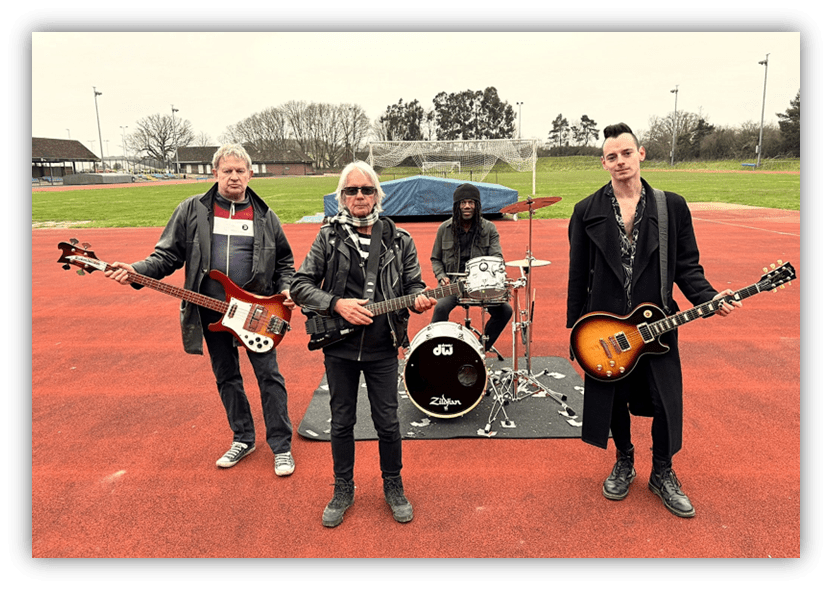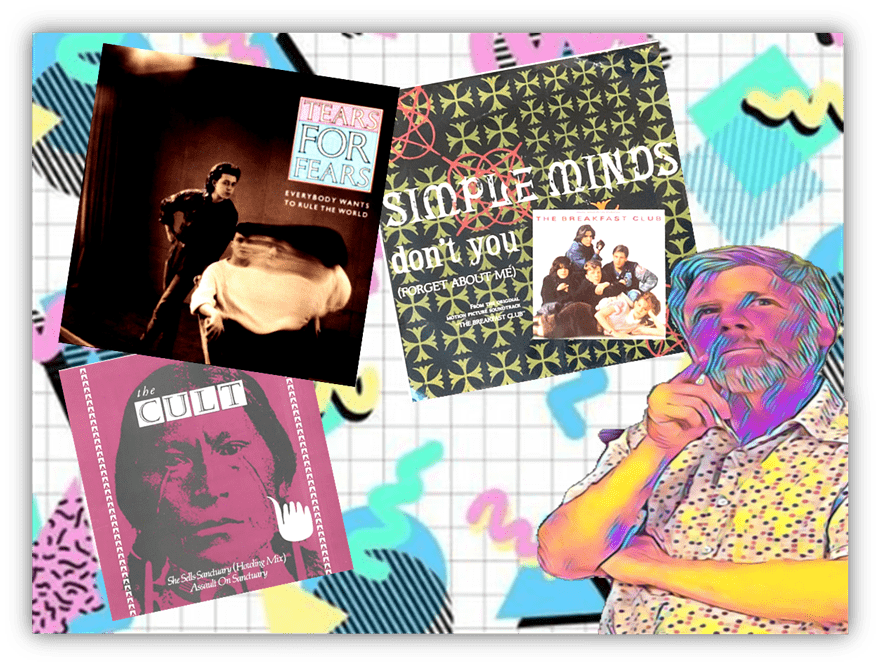Chrissie Hynde rode around on the London Underground feeling sorry for herself.
“Weeping,” she said later.
She had played with nearly everyone in London, and had just finished a tour playing guitar behind someone else. But now that the tour was over she had no prospects.

Everyone she knew was in a band except her.
Crying on the Tube wasn’t a moment of doubt. She never considered giving up. Watching her peers succeed intensified her drive to form her own group.
Born in Akron, Ohio, Hynde couldn’t quite see herself staying there.

Why go to the prom with a classmate when Lou Reed was somewhere out there in the world?
She attended Kent State University and was at the 1970 protest where the National Guard killed four students.
She knew one of the victims. She wanted out of America and moved to London in 1973.
Around the same time, another young American woman, Holly Beth Vincent, also moved to London.
Her parents had each been big band singers in the 1940s, and both she and her brother grew up to become musicians. She learned guitar and drums. When she was 10, the family moved from Chicago to Lake Tahoe, and then to Los Angeles.

She ran away at 16 but returned home, finished high school, and moved to London at 18, a year after Hynde moved there.
Vincent lived with Chris Wood and his wife.
Wood was the woodwind player in Traffic and had co-written “Dear Mr. Fantasy” with Steve Winwood. She auditioned for many bands and artists, including a pre-Dire Straits Mark Knopfler. She didn’t get the gig, but she and Knopfler started dating.
Hynde had several day jobs in London:

Including working retail at SEX, the clothing store run by Vivian Westwood and Sex Pistols manager Malcom MacLaren.
That put her at the center of the early English punk scene.

Her first review was of Neil Diamond’s Jonathan Livingston Seagull soundtrack. She didn’t like it, saying, “This song sounds like an ad for an American small car.”
She got an offer to go to France and front a band called Avec And The Alors. Of course she went – but it wasn’t her thing and she went back to Ohio to join a band called Jack Rabbit.

A Parisian band called The Frenchies sent her a telegram (remember those?) asking her to be their lead singer, and, again, of course she went.
Total time in Ohio? Less than four months. And after about a month in France, she was back in London.
MacLaren set her up in a new band to be called Masters Of The Backside. The other members wanted her to sing lead without playing guitar but that’s not what she wanted to do.

They left her and MacLaren, and became The Damned.
For a very short time, Hynde played with The London SS, which included Mick Jones and Paul Simonon and later evolved into The Clash. This was the band she toured with before finding herself brooding on the Tube.
By September 1976, she’d started a band with the former rhythm section from Johnny Moped, and they planned on calling themselves The Unusuals.

Then she saw an ad that said Johnny Moped was looking for a guitarist. No one told her The Unusuals had broken up.
She started doubting her guitar skills, but Johnny Moped added her as a second guitarist. For a little while.
When her work visa was about to expire, Johnny Rotten said he’d marry her so she could stay in the U.K.

And fhen the Sex Pistols’ naughty-words-on-the-telly incident happened and he backed out, thinking his new infamy would be a problem for her case.
Sid Vicious wasn’t in the Pistols yet and said he’d marry her, but wanted something in return.

Hynde offered him £2.
They went to the registry office, but it was closed for a bank holiday, and they couldn’t go back the next day because Sid had a court appearance he couldn’t miss. She renewed her visa by more traditional means.
After a year and a half in London, Vincent returned home to Los Angeles.
She played drums in a rockabilly band called Brothel Creepers, played guitar in an all female punk band named Backstage Pass, and worked odd jobs.

She and a school friend, drummer Steve Dalton, started a band called Holly And The Italians.
The pair moved to London in 1979, lived with Knopfler, and completed the band’s line up. Free lodging with Knopfler and relentless gigging let Vincent concentrate on writing and performing, rather than look for day jobs as she had back in L.A.
It took most of 1978, but Hynde was finally able to put together the band she had wanted all along.
Dave Hill from Anchor Records heard some of her songs and arranged a temporary rhythm section of Mal Hart on bass and Phil “Philthy Animal” Taylor of Motörhead on drums. A recording session with this line up led Hill to believe in Hynde. She just needed a permanent band.
She first found bassist Pete Farndon, then guitarist James Honeyman-Scott, and then drummer Martin Chambers.

Their first single was a cover of a Kinks song, “Stop Your Sobbing,” written by Ray Davies.
Who Hynde would later marry. They’d have a daughter together.
Nick Lowe produced this first single, but he didn’t work with them again because he thought they didn’t have a future.
Chris Thomas produced the next single, “Kid,” and the third one as well:
“Brass In Pocket” was released on November 12, 1979.
Full of British slang, sexy confidence, and a cool groove, it went to #1 on the UK Singles chart, as well as in Ireland, South Africa, and Sweden.
The following month, Holly And The Italians released a single called “Tell That Girl To Shut Up.”
It only got to #45 on the UK Singles chart, but it was catchy and had plenty of attitude.
The music press thought Holly And The Italians were The Next Big Thing.
Vincent appeared on the cover of several music magazines, some more than once.

The band toured with The Clash, Blondie, and The Selecter, and signed a two album deal with Virgin Records.
They were on their way. All they needed was that first album.
They moved to New York City to record at Electric Lady Studios with Shadow Morton producing.

He had done a lot of the 60’s girl group records.
About five songs into the project, the band fired him and replaced him with Richard Gottehrer, who moved them to The Record Plant and threw out everything Morton had done. Dalton quit the band and Gottehrer brought in lots of session players, including Paul Schaffer, Anton Fig, Jerry Harrison, The Uptown Horns, and an orchestra. Vincent didn’t like the final mix and brought it to John Brand in London to mix it again.

The album The Right To Be Italian came out in February 1981, more than a year after Vincent had left the UK.
She hadn’t been on any British stages or magazine covers since late 1979.
A year is a century in pop music. It didn’t matter how good the album was, she was old news.
The press panned the album.
And though the band toured the US with The Selecter, The Ramones, and The Clash’s Sandinista! tour, they made no headway in the States. Discouraged, the band broke up by the end of the year.
The Pretenders released their second album just 20 months after the first.
It was another success. However, Farndon developed a heroin addiction, and Hynde fired him in 1982.

He died of an overdose the next year.
Two days after Farndon’s firing, Honeyman-Scott died of a cocaine overdose. Hynde fired Chambers in 1985 but rehired him eight years later. He’s been the only other somewhat permanent member.
Meanwhile, Vincent’s relationship with Knopfler soured.
He became convinced that she had used him to boost her career. She broke up with him over the phone while Dire Straits was on tour. He later wrote the song “Romeo and Juliet” about her.
Vincent still owed Virgin a second album.
She went into a London studio with producer Mike Thorne and a group of session musicians.

She used those players as a backing band for a few live performances including an appearance on the Old Grey Whistle Test.
She may or may not have trashed a BBC dressing room and allegedly committed some other misdemeanors elsewhere. Whatever she did or didn’t do, the British government deemed her undesirable while she was in New York getting the album mixed. They didn’t allow her to return.
The album was released as a Holly Beth Vincent solo album but, confusingly, was called Holly And The Italians.

It’s dark, dense, and definitely not pop.
Its cover of Buffalo Springfield’s “For What It’s Worth” brings the paranoia that strikes deep to the forefront. Her manager called it “suicide music” and broke his contract with her. The press hated this record, too.
Both albums aren’t really bad and they’ve earned new respect in hindsight, but they weren’t timed well for her career.
Had the second one been bright and sassy like “Tell That Girl To Shut Up,” it might have been more popular. She went the upbeat route next, and had another minor hit in 1982, duetting with Joey Ramone on a cover of Sonny & Cher’s “I Got You, Babe.”

It got college radio airplay, but didn’t chart.
Three years later, Hynde also did a duet cover of “I Got You, Babe.”
Together with UB40, their version hit #1 in the UK and #28 on the Hot 100.
Vincent went 10 years before releasing another album. She briefly joined The Waitresses as they were recording their second album, Bruiseology.

Disagreements in the band had led to singer Patty Donahue walking out of the sessions.
Vincent — who was still contending with the breakup of both her band and her rather high-profile relationship — only lasted a couple weeks. She simply gave up on the project, and even failed to show up for a performance at Columbia University. The band persuaded Donahue to return.

Vincent sang in Wild Things, the short-lived project put together by Anthony Thistlethwaite of The Waterboys.
Featuring former Rolling Stone Mick Taylor, they released the song “Siberian Mines” in 1984 but it’s now hard to find, available only on rare compilation albums.
Amy Ray of the Indigo Girls asked Vincent to record an album for Ray’s indie label, Daemon Records.
For that 1993 project, Vincent and Dalton got back together and called themselves The Oblivious. Their album America got good reviews but had no hits.
In 1995, Vincent and Johnette Napolitano of Concrete Blonde improvised a feedback laden alt rock album called Vowel Movement.

The name, the unrehearsed songs and performances, and gloomy, muddy tone worked against them.
Since 2000, Vincent released several solo records and has put out house music under the alias yllohas.

She does voice over work, too, including commercials for Nike, Nintendo, and Pepsi.

It’s not the career she expected.
But she follows her vision at any given moment.
Twenty-six Pretenders singles would appear on the UK Singles chart, 10 on Billboard’s Hot 100, and more around the world.
The Pretenders have been around for over four decades, but Hynde has been the leader and only constant member. It’s entirely her vision.

The Pretenders is, and always will be Chrissie Hynde’s band, and it’s the band she always wanted.
Even after losing two crucial early members and facing rejection from the likes of Nick Lowe – who’s smart enough to have known better – she never gave up. Her blend of punk defiance, pop craft, and outspoken activism cements her as a model of artistic integrity.
Holly Beth Vincent goes through long periods of releasing no music, and then putting out a lot at once.
Most of her records have been self-financed or on small labels.
Vincent never achieved Hynde‑levels of fame. But her early singles and aesthetic inspired later Pop Punk and New Wave artists, like Transvision Vamp:

Who had a hit with their cover of “Tell That Girl To Shut Up.”
Her shift to self‑released electronic work and voice acting shows her independent spirit, which her niche audience appreciates.
Chrissie Hynde and Holly Beth Vincent each moved to London twice, had visa and band problems, and made the music they wanted to make.
They harnessed Punk’s DIY spirit to create their own paths.
But:

While Hynde channeled her firm resolve into long term commercial success and critical acclaim:

Vincent’s impetuousness led to a career of bright flashes and dark periods.
Their personalities – Hynde’s committed authenticity versus Vincent’s edgy volatility – shaped both their art and their places in rock history.
And here’s the important part:
The girls didn’t shut up.









Commenters at the Gum turned me onto Holly and the Italians and I instantly loved “Tell That Girl to Shut Up”. I listened to her solo album, and yes, it was dark and moody, but I really liked some of the tracks and kept it in rotation for awhile. More people should know about her.
Agreed. I like that album, too. It wasn’t good for her career path but it was good artistically.
I’d never heard of Holly before. Nice parallels drawn between her and Chrissie. Shows that sometimes its a matter of right place right time with the right support and a bit of luck as to whether you break through.
Listened to those two Holly & The Italians albums this afternoon and on Honalu I could easily have mistaken her for Chrissie. On the debut in particular its a decent enough record and I can hear the same elements that plenty others were using. Maybe it was just too crowded a field to standout.
Good work Bill!
I’m somewhat of a nerdfan of all of the Letterman band members, but I never knew the Will Lee and Paul Schafer connection to Holily and The Italians.
Have some listening to do this weekend. Thanks, Bill!
Holly Beth Vincent needed Team Lauper. I remember owning a Blue Angel cassette. Maybe Vincent didn’t have commercial aspirations. All she had to do, perhaps, was update “Lipstick on Your Collar”, or any oldie of its ilk. She should’ve been at the very least, Tracey Ullman. I developed this opinion only after seeing you list “Tell That Girl to Shut Up” by Holly and the Italians on the mothership. I think I wrote something really deep like hey, it’s a cover?